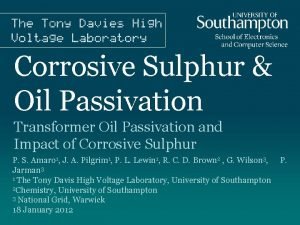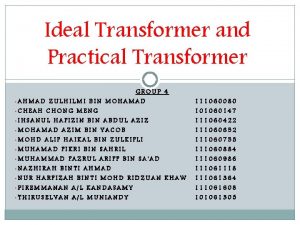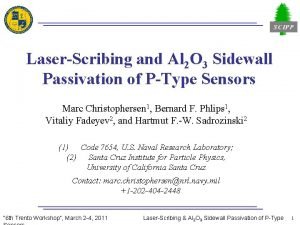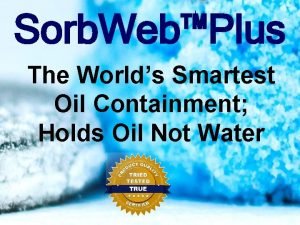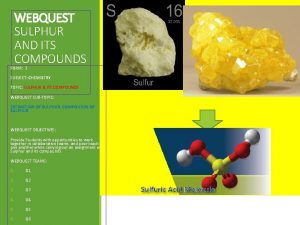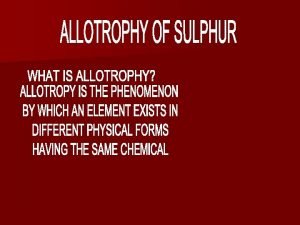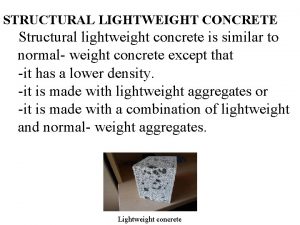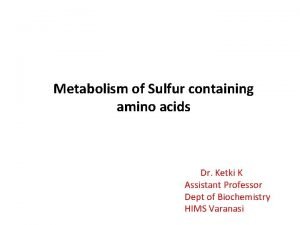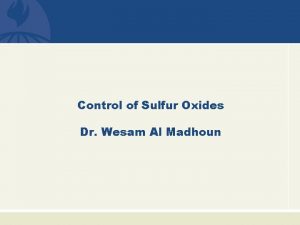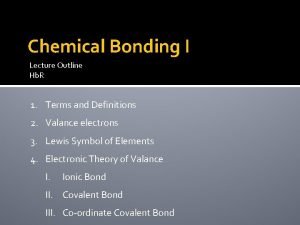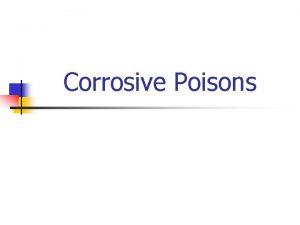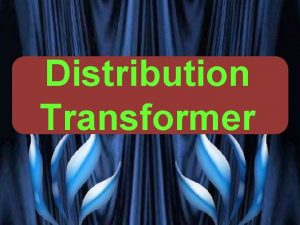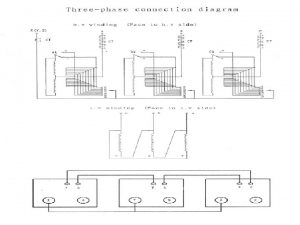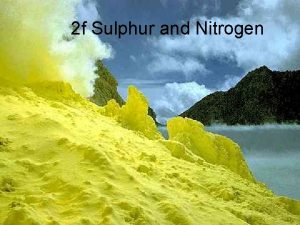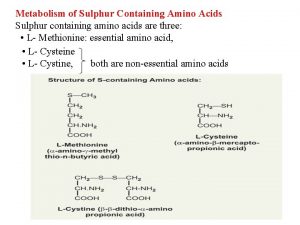Corrosive Sulphur Oil Passivation Transformer Oil Passivation and


















- Slides: 18

Corrosive Sulphur & Oil Passivation Transformer Oil Passivation and Impact of Corrosive Sulphur P. S. Amaro 1, J. A. Pilgrim 1, P. L. Lewin 1, R. C. D. Brown 2 , G. Wilson 3, Jarman 3 1 The Tony Davis High Voltage Laboratory, University of Southampton 2 Chemistry, University of Southampton 3 National Grid, Warwick 18 January 2012 P.

Presentation Overview • Effects of Corrosive Sulphur in Insulation Oil – Development of Faults – Detection Mechanisms – Current Research Focus • Transformer Oil Passivation – Physical Property Changes – Short & Long-term Effects • Conclusion and Further Work 2

Corrosive Sulphur Impacts

Corrosive Sulphur • “Elemental sulfur and thermally unstable sulfur compounds in electrical insulating oil that can cause corrosion of certain transformer metals such as copper and silver” ASTM D 2864 • Not formed in transformer’s normal operational conditions – Known sources of contamination: poorly refined crude oil, addition of chemical compounds – Other Suspected sources: gaskets, water-based glues, copper and Kraft paper 4

Sulphur Compounds • Multiple Sources = Multiple Compounds • Thiophens, Disulphides, Thio-ethers, Mercaptans, Sulphur Increasing order of corrosion • Dibenzyl-disulphide (DBDS) was identified experimentally to be primary compound in corrosive sulphur related faults Contaminated Conductors (G. Wilson, National Grid) 5

Cu 2 S Faults Development DBS DBDS Schematic of Cu 2 S formation mechanism (CIGRE Final Report 2009, WG A 2 -32) 6

Fault Location in Transformer Copper Conductor Insulating Paper Cu 2 S Short-Circuited Cu 2 S Copper Conductor Cu 2 S transformer fault (G. Wilson, National Grid) • Copper Sulphide accumulates and bridges two coil turns • Due to the semiconductive nature of Cu 2 S a short circuit occurs and a turn-to-turn fault is developed

Detection Methods • Qualitative Plain Copper ASTM D 1275 A/B & Covered Conductor Deposition (CCD) IEC 62535 Tests – Copper strip immersed in oil, accelerated aging conditions – CCD has a layer of Kraft paper around the copper strip ASTM copper strip corrosion standard • Quantitative Test – Alumina-based solid phase extraction + Gas Chromatography-Mass Spectrometry (GC-MS) detect DBDS to a level of 0. 1 ppm (Toyama et al. , 2009) 8

Mitigating Techniques • Oil Replacement – 5 -12% of contaminated oil remains after retro filling – Quantity of oil absorption materials, shape of the transformer tank, the location of the drainage valve • Oil Depolarisation – Combination of solid reagents, chemicals and sorbents – Reduces DBDS content to 5 mg/kg (5 ppm) – Transformer can be on or off-load – Also removes metal passivator and water content • Passivation 9

Research Objectives for Cu 2 S • Relationship of variables such as Temperature and Oxygen • Measurable electrical property changes • Model the degradation process • Develop an online condition monitoring technique for Cu 2 S Deposition on Insulation Paper (G. Wilson, National Grid) 10

Transformer Oil Passivation

Oil Passivation • Passivation is a technical term used to define the formation of non-permeable surface layers on metal • Triazole-based passivators – 1, 2, 3 -benzotriazole (BTA) – Irgamet 39 TM (CIBA Speciality, Basel, Switzerland) • Previous use of passivators: – Japan for reducing streaming charging tendency, Australia for improved oxidation inhibition 12

Effects of Passivation • Short-term – Suppress Copper Sulphide – The increase of H 2, CO and CO 2 concentration is occurs in the first seven days after passivating the insulation oil. • Long-term – The passivation is depleted and oil returns to its corrosive level 13

Research Objectives for Passivation • Stability of the non-permeable surface layers on metal • Effects on Oil and Paper insulation • Relationship of passivator to metal (m 2) and to DBDS(ppm) • Thermal & Electrical property alterations • Analytical tools to quantify the degradation of passivator 14

Conclusion & Future Work

Conclusion • Corrosive Sulphur & Oil Passivation – Define Relationship between enviromental variables – Detect electrical properties changes – Model degradation process • Current stage of research project – Assessment of the corrosive sulphur and oil passivation state-of-the-art knowledge 16

Future Work • Frequency Dielectric Spectroscopy (FDS) – Use low frequency range spectrum to evaluate paper, pressboard dielectric loss and oil conductivity – Previous experiments have been able to identify different moisture contents in Kraft paper • Polarisation Depolarisation Currents (PDC) – Applied dc , short circuit to ground, voltage build-up – Each materials has specific relaxation times 17

Thank you
 Corrosive sulfur passivator
Corrosive sulfur passivator Activation and passivation in adf
Activation and passivation in adf Compare ideal and practical transformer
Compare ideal and practical transformer Sidewall passivation
Sidewall passivation Why transformer called static device
Why transformer called static device Sorbweb
Sorbweb Difference between sulphur and vat dyes
Difference between sulphur and vat dyes Sulphur and its compounds klb notes
Sulphur and its compounds klb notes So2br2
So2br2 Creaming is a.......... process
Creaming is a.......... process Aeries parent portal sulphur springs
Aeries parent portal sulphur springs Sulphur cycle
Sulphur cycle Secondary element
Secondary element Sulphur impregnated concrete
Sulphur impregnated concrete Tyler socorro
Tyler socorro Importance of sulphur containing amino acids
Importance of sulphur containing amino acids Importance of sulphur containing amino acids
Importance of sulphur containing amino acids Control of sulphur dioxide
Control of sulphur dioxide Sulphur dioxide lewis structure
Sulphur dioxide lewis structure
